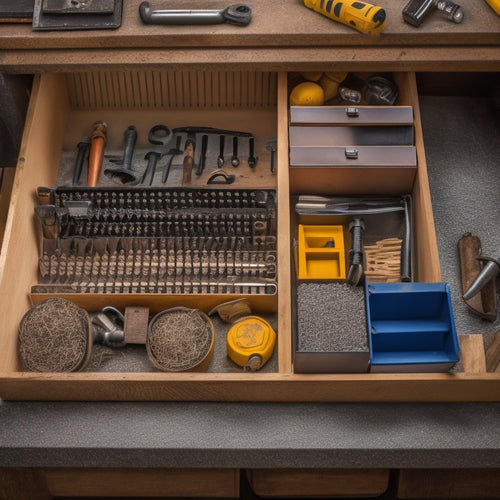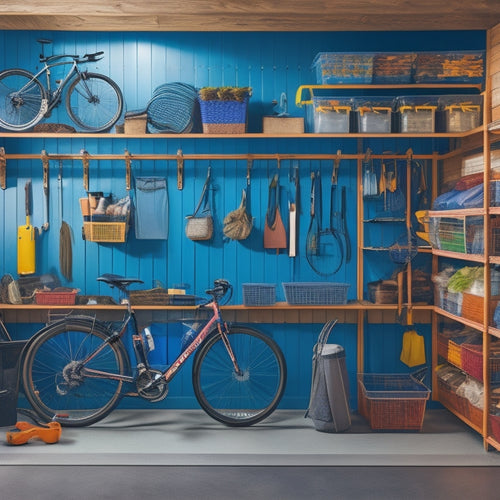
3 Essential Tools for Woodworking Budget Mastery
Share
To master woodworking budgets, you'll need three indispensable tools. First, a dependable expense tracking system helps you accurately track every dollar spent, identify cost-saving opportunities, and make informed decisions. Second, a simple spreadsheet or calculator is crucial for precise material cost calculations, considering quantity, quality, and waste factors. Finally, a contingency fund allocation guarantees you're prepared for unexpected expenses, such as equipment failures or material shortages. By leveraging these tools, you'll avoid cost overruns and stay on track. As you build your budgeting expertise, you'll uncover even more strategies to optimize your woodworking projects.
Key Takeaways
• Accurate expense tracking is crucial for woodworking budget mastery, and utilizing budget tracking apps or software can simplify the process.
• Precise material cost calculations, considering quantity, quality, and waste factors, help avoid cost overruns and ensure project success.
• Allocating a contingency fund for unexpected expenses, such as equipment failures or material shortages, helps stay on track with project timelines and budgets.
• A simple spreadsheet or calculator can be used to break down material costs, including often-overlooked items like fasteners, adhesives, and finishes.
• Regularly analyzing spending patterns and identifying cost-saving opportunities enables informed decision-making and optimized budget management.
Tracking Expenses Made Easy
To master woodworking on a budget, you need to accurately track every dollar spent, and a reliable expense tracking system is essential for achieving this goal. With the right tools, you'll be able to identify areas where you can cut costs and make adjustments to stay within your budget. Expense tracking software and budget tracking apps can help you keep tabs on your spending, providing a clear picture of where your money is going.
By analyzing your spending patterns, you'll be able to pinpoint areas where you can optimize your expenses. A thorough spending analysis will give you a detailed cost breakdown, enabling you to make informed decisions about your woodworking projects. You'll be able to see exactly how much you're spending on materials, tools, and other expenses, and make adjustments accordingly.
With a clear understanding of your expenses, you'll be able to create a realistic budget that works for you, not against you. By implementing an effective expense tracking system, you'll be well on your way to mastering woodworking on a budget.
Accurate Material Cost Calculations
Your woodworking projects' success hinges on precise material cost calculations, which involve more than just guessing or estimating the cost of lumber, hardware, and other essentials.
To avoid cost overruns, you need to accurately calculate the cost of each material, taking into account factors like quantity, quality, and waste.
A simple spreadsheet or calculator can help you break down the costs of each component, including the cost of fasteners, adhesives, and finishes.
Budgeting for Unexpected Expenses
As you finalize your woodworking project's budget, don't overlook the significance of allocating a contingency fund to cover unexpected expenses that inevitably arise. Emergency fund planning is pivotal to avoiding financial stress and project delays. Aim to set aside 10-20% of your total budget for unexpected expenses, such as equipment failures or material shortages.
| Expense Type | Probability | Cost Impact |
|---|---|---|
| Equipment Failure | High | $500-$1,000 |
| Material Shortage | Medium | $200-$500 |
| Labor Overtime | Low | $100-$300 |
When creating your contingency plan, consider negotiating discounts with suppliers or exploring cost-saving measures, such as buying second-hand equipment or using alternative materials. By accounting for unexpected expenses, you'll be better equipped to handle unexpected setbacks and stay on track with your project timeline and budget. Remember, it's always better to be prepared for the unexpected than to risk derailing your entire project.
Frequently Asked Questions
How Do I Prioritize Tool Purchases for My Woodworking Business?
When prioritizing tool purchases for your woodworking business, you should consider tool quality and affordability, as well as brand reputation and tool longevity, to guarantee you're investing in reliable, long-lasting equipment that meets your needs and budget.
Can I Claim Woodworking Tools as Tax Deductions for My Business?
You're wondering if you can write off those pricey woodworking tools as tax deductions for your business? Yes, you can, but only if you've kept meticulous records of your business expenses, proving they're essential to your operation.
What Are Some Free Woodworking Project Planning Software Options?
You'll find free woodworking project planning software options like SketchUp, Tinkercad, or Fusion 360, which help you visualize design ideas, estimate material costs, and create a project timeline, ensuring efficient resource allocation.
How Do I Determine the Depreciation Value of My Woodworking Tools?
"As you gaze upon your woodworking arsenal, imagine each tool's value slowly whittling away like a freshly sharpened chisel on a cedar plank. To determine depreciation value, you'll calculate the tool's cost, useful life, and salvage value, then apply budgeting strategies like the straight-line method or units-of-production method."
Are There Any Woodworking Budgeting Apps Available for Mobile Devices?
You can track your woodworking expenses on-the-go with mobile apps like Expensify, Mint, or Personal Capital, which offer budget tracking and expense management features to help you monitor and optimize your woodworking tool investments.
Related Posts
-

Small Shelving Options for Tight Spaces
You're surrounded by tight spaces in your home, and you need clever shelving solutions that optimize storage without ...
-

Best Screw Storage Bins for Organizing Your Toolbox
You need a reliable screw storage system to maximize your productivity and efficiency, and that's exactly what the ri...
-

Garage Wall Storage Ideas to Boost Productivity
You can enhance your garage's productivity by capitalizing on your ceiling height with overhead racks, storing bulky ...


